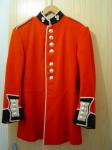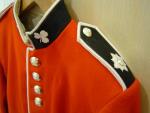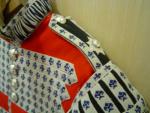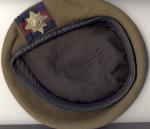-
Posts
2,123 -
Joined
-
Last visited
-
Days Won
3
Content Type
Profiles
Forums
Blogs
Gallery
Events
Store
Everything posted by Paul L Murphy
-
The box I saw was slightly more tan in colour but pretty close to this.
-
The only original box I have seen for this was made from brown lacquer, not black. The ribbon here is too "fresh" looking also it is unwatered, the original ribbon is watered silk.
-
The medal is real but the ribbon is a modern replacement (the auction description does say this). The box is not original either. I would be surprised if it goes for less than 500,000 yen.
-

Michael Collins cap badge Adams sale April 2010
Paul L Murphy replied to molders's topic in Northern European & Baltic States
I know a couple of people who handled it and all said it was the larger post 1924 patttern size, not the earlier version. -
It is from the 1970s or later.
-
I have gone through my various reference books and cannot find anything (so they are not in the standard French books for these badges).
-

Third Reich Collector Stamps?
Paul L Murphy replied to bmsm's topic in Coins & Commemorative Medallions
Dan, Send me a PM with your email address since I am disposing of a collection of German stamps and it includes many of the 3rd Reich era sets that might be of interest to you. Regards, Paul -
The characters are a woman's name (it is the same characters on the lid and inside). Also this case was used for Japanese Red Cross medals as well so I suspect it was put together with the Manchurian medal since a female recipient would have had a bow ribboned medal. Still a nice medal though and getting hard to find.
-

Michael Collins cap badge Adams sale April 2010
Paul L Murphy replied to molders's topic in Northern European & Baltic States
I agree with you on this one. It is definitely a post 1924 cap badge. If you look at photos of Collins in Free State Army uniform his cap badge is smaller than this pattern (which did not exist while he was alive). The auction description is also carefully worded. Somebody was burnt on this, a rather expensive lesson. -
A huge number of organisations in Imperial Japan issued badges and medals with the approval of the government, however they are awards of those individual groups and not government issued awards. The Butokukai, and indeed other groups such as the Patriotic Women's Association or the Imperial Time Expired Soldier's League, were able to issue their own awards that could in many cases be worn in uniform but they had no direct role in deciding who got government awards such as the Sacred Treasure or Rising Sun. I believe this latter point was the gist of the original question in post 1 of this topic.
-
They had no role in the issuance of medals. While they are an official organisation their activities were (and are) in the area of martial arts and the promotion thereof.
-

The Medals and Decorations of General Fukushima
Paul L Murphy replied to Richard LaTondre's topic in Japan
Interesting. I can work out that this would have been a five level increase, but not six ! Even then you have to think that the Rising Sun and Sacred Treasure are two levels (even for the same class). A 3rd Class Sacred Treasure would normally have been earned by an officer below the rank of general once they had served about 30 years since it tended to be used as a long service award in the military. I guess they wanted something to hang around his neck but the 3rd Class Rising Sun was a step too far. -

The Medals and Decorations of General Fukushima
Paul L Murphy replied to Richard LaTondre's topic in Japan
A 5th Class or 4th Class Rising Sun would have been the normal award that a Lt Colonel would have received. -
Superb, much nicer condition than the norm.
-
This is almost certainly a military award for the China Incident since it was awarded on 29th April 1940. Showa order certificates do not show military rank, only Meiji era order certs have the recipients rank details. What this certificate does show is that the recipient was already a holder of an 8th class award (either a Rising Sun or Sacred Treasure, one cannot tell which from the cert). Hence this is almost certainly an NCO who either won an 8th class Rising Sun at an earlier time (some soldiers got the 8th class in the Manchurian Incident and went on to win the 7th as NCOs post 1937) or else has served over 20 years so he got the 8th class Sacred Treasure for long service. If you are interested in WWII items then this is worth keeping.
-

The Irish Guards.
Paul L Murphy replied to leigh kitchen's topic in Great Britain: Militaria: Badges, Uniforms & Equipment
Unfortunately not. I have always baulked at the price they go for on ebay etc ! -

The Irish Guards.
Paul L Murphy replied to leigh kitchen's topic in Great Britain: Militaria: Badges, Uniforms & Equipment
-

The Irish Guards.
Paul L Murphy replied to leigh kitchen's topic in Great Britain: Militaria: Badges, Uniforms & Equipment
-

The Irish Guards.
Paul L Murphy replied to leigh kitchen's topic in Great Britain: Militaria: Badges, Uniforms & Equipment
-

The Irish Guards.
Paul L Murphy replied to leigh kitchen's topic in Great Britain: Militaria: Badges, Uniforms & Equipment
-

The Irish Guards.
Paul L Murphy replied to leigh kitchen's topic in Great Britain: Militaria: Badges, Uniforms & Equipment
Just to add a few bits and pieces of Irish Guards items that I have in my collection. Up first a standard beret for a Guardsman with recent issue cap badge. Next a full dress shoulderboard for a captain in the Irish Guards, followed by a full dress shoulderboard for an NCO. -

JAPANESE OCC. TERR. BANKNOTES.
Paul L Murphy replied to Mervyn Mitton's topic in Coins & Commemorative Medallions
These are an interesting collecting area, and most notes are relatively inexpensive. The Japanese issued 35 different occupation notes for China and Indochina, 14 notes for the Dutch East Indies, 10 for Malaya, 13 for Philippines, 9 for Burma and 4 for Australia. Obviously the Australian notes were never used ! Prior to this they issued military notes for the Sino-Japanese War, Russo-Japanese War, Tsingtau Expedition in 1914-15 and the Siberian Expedition in 1919-20. Most of these earlier notes are scarce and expensive with almost no examples of Sino Japanese War notes surviving.
















